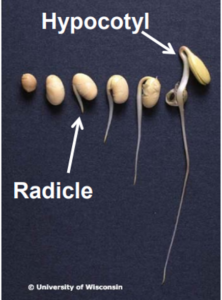Illinois has planted 38% of soybean acres as of May 15, for the year. Looking at the weather forecast, things will be ramping up quickly and many more acres of soybeans will be planted. Once the bean seed is out of the planter and in the ground, what really happens to it? Let’s take a deep dive and look at the physiological processes happening from germination to the start of vegetational growth.
Seeds are living organisms and will remain stable until a desirable condition is met and initiates germination. With soybeans, moisture content is the big initiator of germination as approximately 50% of the seed weight needs to be absorbed into the seed. This process is called imbibition and happens rapidly, usually under 24 hours, depending on soil moisture. Following imbibition, cell division will begin allowing the radicle to grow and push out of the seed coat first. The radicle develops into the primary seedling root and will produce lateral roots as it elongates. This all happens within 36 to 48 hours after the seed has imbibed enough water.

Next, the hypocotyl, or the seedling stem, will begin to elongate and form a hook to pull the cotyledons with it through the soil to the surface. This type of emergence is known as epigeal emergence. Once out of the ground, the hypocotyl will straighten, and the cotyledons will unfold and turn green with exposure to sunlight. When the cotyledons are fully opened, the epicotyl is revealed. The epicotyl is the main growing point for the plant and contains the unifoliates and the first trifoliate. That means the soybean seed itself housed the cotyledons, the unifoliates, and the first trifoliates! At this point, the soybean can be growth staged at VE, or vegetative emergence, and can occur as soon as five days after planting.
Back to the cotyledons – they are the source of nutrients for the young soybean seedling as the plant gets to growing. They are a thick, waxy, dense plant structure that are not considered to be the soybeans’ first true leaf. However, they are still very important as they hold the plant’s energy, much like the corn seed does for a corn seedling; plus, they can capture a small amount of light energy. The cotyledons supply about 7-10 days of nutrient needs for the seedling and will lose about 70% of their dry weight from nutrient remobilization throughout the plant. If the cotyledons are injured or broken, but the epicotyl is still intact, the plant will continue to live. However, the loss of both cotyledons can reduce yields by 2-7%.
As the soybean germinates and emerges, there are three factors that play a key role in the success or struggles of plant establishment.
- Soil conditions – soil moisture and soil temperature. The later we get planted this year, the less a concern with cool soil temperature. Soil moisture will still be one factor to watch. Be sure to plant into a moist soil to initiate and sustain the imbibition process. Planting into too wet of soil will be a cause of concern for compaction and/or crusting.
- Seed quality – Germination rates will need to be taken into consideration for the success of an ideal stand establishment. Varieties with low germ scores should not be expected to have 100% emergence in the field.
- Weather forecast – A pounding rain looming in the forecast? A soil crust may prevent the ability of the hypocotyl to pull the cotyledons to the surface. A dry spell for the next week? Planting deep enough into moisture will be key to providing enough water for emergence.
Keeping in mind how soybeans germinate, emerge, and the factors that could impact these processes, will help set up a successful stand establishment for the growing year.
Sources:
https://extension.umn.edu/growing-soybean/soybean-growth-stages
https://www.agry.purdue.edu/ext/soybean/arrivals/10soydevt.pdf




 and then
and then